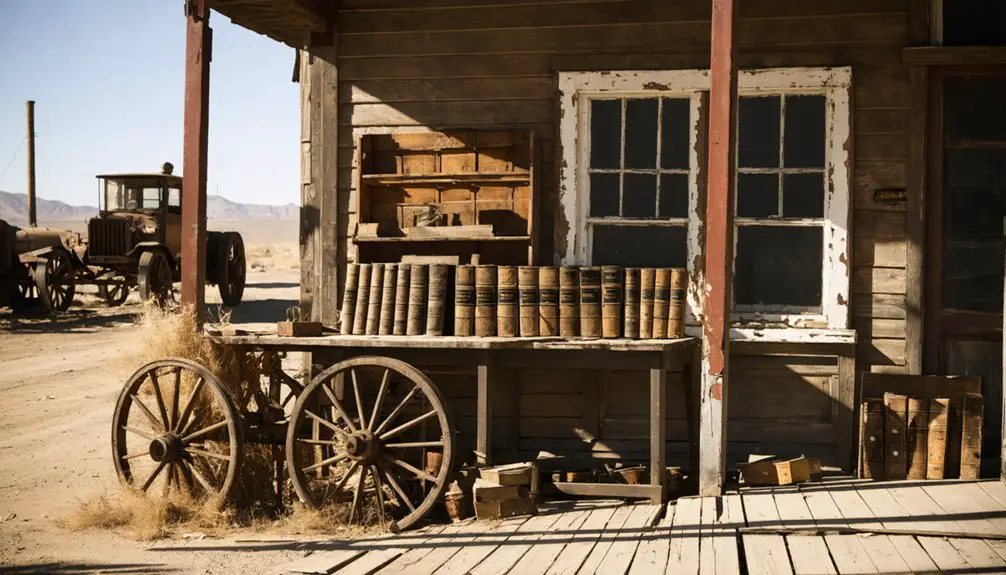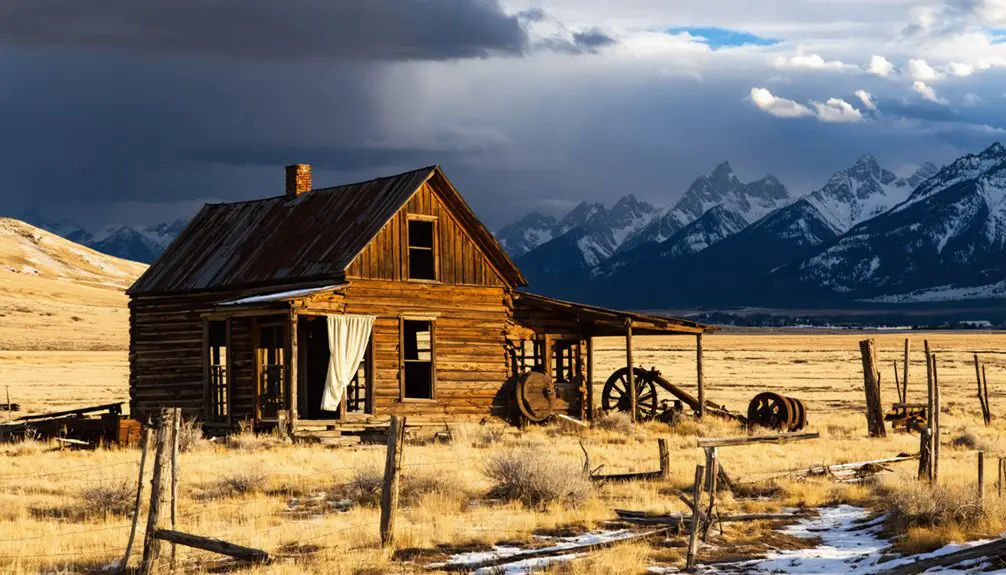You’ll find Wyoming’s frontier past steeped in tales of lawless boomtowns like Benton, where daily murders and public hangings marked its chaotic 90-day existence. Communities like Bear River City erupted in deadly riots, while Tubb Town vanished overnight when the railroad moved on. From vigilante justice to 24/7 saloons and gambling halls, these ghost towns tell stories of rapid rises and dramatic falls. The remnants of this turbulent era await your discovery across Wyoming’s haunting landscape.
Key Takeaways
- Benton’s 90-day descent into lawlessness saw daily murders and public hangings before becoming a ghost town in 1868.
- Bear River City erupted in violence when 300 armed laborers burned the town after vigilantes hanged three railroad workers.
- Tubb Town’s entire population abandoned the settlement in a single day after the railroad company chose Newcastle instead.
- Wyoming’s mining towns experienced dramatic 40-year cycles of explosive growth followed by swift, devastating economic collapse.
- Historic saloons operated 24/7, hosting gambling, entertainment, and frontier justice, with bullet holes still visible in buildings today.
The Rise and Fall of Benton: 90 Days of Lawlessness
While many frontier towns earned reputations for lawlessness, few matched the intensity of Benton, Wyoming, during its brief but violent existence in 1868.
Located 11 miles east of modern-day Rawlins, this railroad track-end town descended into chaos within months of its founding. You’d find a transient population of merchants, gamblers, and “western roughs” packed into a stretch of saloons and gambling tents merely 100 by 40 feet wide. Water had to be hauled from the North Platte River and cost residents one dollar per barrel.
Benton’s chaos manifested in daily murders, public hangings by mob justice, and brutal domestic violence. The area’s reputation mirrored that of Johnson County’s lawlessness, which would later become Wyoming’s most dangerous region. Despite its ambitions as a commercial hub for cattle operations, the town’s lawless atmosphere drove away anyone seeking stability.
Mob justice and daily bloodshed turned Benton into a living hell, driving away even the hardiest frontier settlers.
After just 90 days of peak violence, Benton’s population dwindled as the railroad moved on, leaving behind a ghost town’s haunting legacy.
Bear River City’s Violent Legacy: The Riot That Changed Everything
You’ll find Bear River City’s darkest chapter written in the ashes of November 1868, when vigilante justice sparked a devastating riot that claimed 16 lives.
The powder keg ignited after a vigilance committee hanged three railroad workers, prompting 300 armed associates, mostly Irish laborers, to exact revenge by burning the town and attacking the *Frontier Index* newspaper office that had endorsed the killings.
What started as a thriving “Hell on Wheels” boomtown along the Transcontinental Railroad ended in flames and martial law, marking Bear River City’s swift transformation from a bustling settlement to a haunting Wyoming ghost town. US Cavalry troops from Fort Bridger were dispatched to restore order in the chaotic aftermath.
The town’s brief but notorious reputation earned it the distinction of being one of the most wicked cities in America during its peak.
Vigilante Justice Sparks Chaos
In the late 1860s, Bear River City’s descent into vigilante violence transformed a bustling railroad town into a cautionary tale of frontier justice gone wrong.
You’ll find that mob mentality took hold when vigilantes lynched three suspected criminals, sparking a devastating chain reaction that would tear the community apart.
- 300 armed rioters stormed the streets in retaliation
- The Frontier Index newspaper office burned to the ground
- Marshal Thomas J. “Bear River Tom” Smith fought to restore order
- 16 lives were lost in a single night of chaos
The clash between vigilante morality and lawlessness reached its breaking point on November 19, 1868, when friends of the lynched men launched their revenge.
Smith led an angry mob that set The Frontier Index ablaze by 8 a.m., driven by his previous conflicts with the newspaper.
Even with Marshal Smith’s brave attempts to mediate, the powder keg of tension between laborers, vigilantes, and law enforcement exploded into full-scale destruction.
The arrival of U.S. Cavalry troops finally brought an end to the bloodshed through the imposition of martial law.
From Boomtown to Ashes
Following the vigilante lynchings, Bear River City’s fate was sealed through a devastating chain of events that would transform Wyoming’s most notorious boomtown into a cautionary tale of frontier justice.
You can trace the town’s rapid demise to November 19, 1868, when 300 armed desperados released their fury against the vigilantes who’d executed their friends. As community tensions exploded, the mob torched the Frontier Index newspaper office and sparked shootouts throughout the streets. The riot began after workers became enraged by critical newspaper coverage of their efforts.
Despite Marshal Thomas “Bear River Tom” Smith’s efforts, law enforcement couldn’t contain the chaos that claimed 16 lives. When U.S. Cavalry troops arrived to impose martial law, they found a town in ruins.
The Union Pacific Railroad ultimately bypassed Bear River City for nearby Evanston, leaving behind empty buildings and painful memories of a community torn apart by vigilante violence.
Life in the Wild West: Saloons, Gambling, and Frontier Justice
While the romanticized Wild West often conjures images of cowboys and cattle drives, Wyoming’s saloons served as the true epicenters of frontier life, where gambling, entertainment, and frontier justice converged under one roof.
From the first establishment at Brown’s Hole in 1822 to iconic venues like the Occidental Hotel, these gathering spots shaped the territory’s saloon culture and gambling dynamics. Popular games included Faro and Brag, with high-stakes gambling attracting both honest workmen and professional players. The establishment of saloons marked important mining boom settlements across the western territories.
Wyoming’s early saloons, from Brown’s Hole to the Occidental Hotel, laid the foundation for the territory’s vibrant gambling and entertainment culture.
- Dance hall girls earned commissions from both dancing and drink sales, with tickets costing up to $1.
- Many saloons operated 24/7 without front doors, maximizing accessibility.
- The Occidental Hotel’s original bar still bears bullet holes from historic shootouts.
- Lawmen and outlaws frequently crossed paths in these establishments, blurring justice’s boundaries.
You’ll find these preserved pieces of Wyoming’s past still standing today, each telling tales of a time when frontier justice was served alongside whiskey and poker hands.
Tubb Town: A Railroad Settlement’s Swift Demise
Founded by ambitious entrepreneur DeLoss Dewitt Tubbs in spring 1889, Tubb Town emerged as a speculative settlement aimed at capitalizing on the Chicago, Burlington, and Quincy Railroad’s expansion through Wyoming Territory.
Tubb Town’s rise began with a general store and quickly attracted railroad workers, becoming a bustling frontier community known for its saloons and dance halls.
You would’ve found a lively atmosphere where newcomers earned their welcome by buying rounds at local bars.
However, when the railroad company chose to establish Newcastle just miles away, Tubb Town’s fate was sealed.
On September 10, 1889, the entire population, including businesses, abandoned the settlement for Newcastle.
Similar to Bear River City’s riot, the town’s brief existence highlighted the volatile nature of railroad settlements in Wyoming Territory.
Tubb Town’s legacy stands as a stark reminder of how railroad companies’ decisions could instantly transform Wyoming’s landscape, turning boom towns into ghost towns overnight.
From Boom to Bust: The Economics Behind Wyoming’s Ghost Towns

When you look at Wyoming’s ghost towns, you’ll find a recurring pattern of rapid economic growth followed by devastating collapses. Communities like Jeffrey City lost 95% of their population when single-industry economies failed.
Railroad settlements experienced similar boom-bust cycles, with investors pouring money into infrastructure and businesses during peak periods, only to abandon their investments when resource markets crashed.
These economic cycles created a landscape dotted with abandoned buildings and empty streets, where once-thriving communities saw their populations dwindle to just a handful of resilient residents.
Rapid Growth, Swift Collapse
Throughout Wyoming’s history, mining towns experienced a predictable yet devastating pattern of explosive growth followed by swift economic collapse. You’ll find these stark reminders of economic vulnerability scattered across the state’s landscape, where once-thriving communities built their hopes on mineral wealth.
- Mining booms typically lasted about 40 years before communities faced their inevitable decline.
- Smaller, isolated towns dependent on single resources suffered the most dramatic collapses.
- Geographic limitations often sealed a town’s fate, making recovery nearly impossible.
- Population shifts gradually moved away from mining centers, weakening community identity.
The rush for mineral wealth created temporary prosperity, but without economic resilience, these towns couldn’t survive market downturns.
Their empty streets and abandoned buildings now stand as silent witnesses to the risks of building communities around single industries.
Railroad Town Investment Cycles
Railroad companies in Wyoming orchestrated three distinct waves of townsite investment during the territorial period, each driven by speculation in natural resources and real estate development.
You’ll find these investment cycles followed a predictable pattern: railroad economics drove initial growth through resource exploitation – timber, coal, oil, and agriculture – while real estate speculation fueled rapid town development along the rail lines.
As you explore Wyoming’s ghost towns today, you’re witnessing the aftermath of this investment speculation. Railroad companies promoted townsites aggressively, often platting areas far larger than demand warranted.
When resource booms went bust, these towns faced swift decline. Many railroad operators had to abandon service entirely, leaving communities stranded.
The cycle of boom and bust shaped Wyoming’s landscape, with failed railroad towns scattered across the territory like fallen chess pieces.
Exploring the Remnants: A Journey Through Time
Hidden across Wyoming’s vast landscapes, remarkable remnants of the American frontier tell stories of cultural crossroads, military conflicts, and pioneering spirit.
You’ll discover historic landmarks that shaped the nation’s westward expansion, from ancient archaeological sites to preserved military outposts.
- Explore military forts like Fort Bridger and Fort Phil Kearny, where cavalry once defended frontier settlements
- Walk the actual ruts carved by Oregon Trail wagons, still visible after more than 150 years
- Visit the mysterious Medicine Wheel, an ancient Native American site with spiritual significance
- Step into South Pass City’s gold rush era buildings, frozen in time since the 1800s
These preserved sites aren’t just tourist attractions – they’re windows into defining moments that shaped America’s identity, waiting for you to uncover their secrets.
Frequently Asked Questions
What Did Women Typically Do for Work in Wyoming Ghost Towns?
You’ll find women’s roles in ghost town industries included running boarding houses, saloons, newspapers, and shops, while others worked as teachers, laundresses, and property owners with newfound voting rights.
How Did Extreme Weather Conditions Affect Daily Life in These Settlements?
You’d face brutal survival challenges daily, from farming in frozen soil to reinforcing shelter against blizzards. Extreme temperatures forced constant adaptations, while isolation and limited resources tested your community’s resilience.
What Happened to Children’s Education in These Rapidly Abandoned Towns?
Like dominos falling, you’d see school closures ripple through mining towns as families fled. Your children’s educational resources vanished when mines shut down, forcing communities to abandon their cherished schools.
Were There Any Successful Attempts to Revive Abandoned Wyoming Ghost Towns?
You’ll find South Pass City stands as Wyoming’s most successful ghost town revival, transformed into a state historic site with over 20 preserved buildings and active tourism through Gold Rush Days events.
What Indigenous Tribes Inhabited These Areas Before the Ghost Towns Emerged?
You’ll find rich Native tribes like the Shoshone, Arapaho, Crow, and Cheyenne shaped Wyoming’s cultural heritage long before ghost towns appeared, with their ancestral lands spanning these future settlements.
References
- https://www.wyomingcarboncounty.com/things-to-do/?id=123:5-ghost-towns-to-explore
- https://sites.rootsweb.com/~wytttp/ghosttowns.htm
- https://en.wikipedia.org/wiki/Tubb_Town
- https://www.geotab.com/ghost-towns/
- https://wyoarchives.wyo.gov/index.php/find-it-in-the-archives/records-of-wyoming-cities-towns-municipalities/57-find-it-in-the-archives
- https://cowboystatedaily.com/2024/11/09/wyoming-history-in-1868-benton-was-so-violent-murder-was-part-of-daily-life/
- https://www.onlyinyourstate.com/state-pride/wyoming/johnson-county-wyoming-history-wy
- https://wyomingwhispers.com/benton-wy-ghost-town/
- https://travelwyoming.com/blog/stories/post/experience-outlaw-history-in-wyoming/
- https://truewestmagazine.com/article/a-journey-through-wyomings-outlaw-history/



